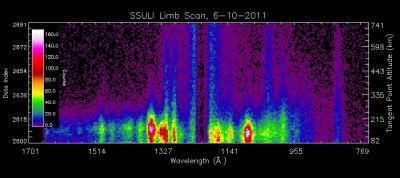WASHINGTON -- Data products from the Special Sensor Ultraviolet Limb Imager (SSULI) developed by the NRL Spacecraft Engineering Department and Space Science Division were officially transitioned for use in operational systems at the Air Force Weather Agency (AFWA) on June 9, 2011.
After extensive validation of the SSULI sensor software and derived atmospheric specification, the Air Force Weather Agency received a formal letter from the Defense Weather Systems Directorate (DWSD) at the Air Force Space and Missile Systems Center (SMC) recommending that they begin using the SSULI data as inputs into Space Weather models and also as standalone data products.
"These datasets now in use at the Air Force Weather Agency provide key understanding of the atmosphere for both Department of Defense and civilian users," said Sean Lynch, program manager, NRL Spacecraft Engineering Department.

This is an example scan from the SSULI instrument, x-axis represents wavelength, y-axis is altitude and the color represents accumulated counts in one orbit (101 minutes).
(Photo Credit: Naval Research Laboratory)
SSULI measures vertical profiles of the natural airglow radiation from atoms, molecules, and ions in the upper atmosphere and ionosphere from low earth orbit aboard the DMSP satellite. It builds on the successes of the NRL High Resolution Airglow/Aurora Spectroscopy (HIRAAS) experiment flown aboard the Department of Defense (DoD) Space Test Program (STP) Advanced Research and Global Observations Satellite (ARGOS). SSULI makes measurements from the extreme ultraviolet (EUV) to the far ultraviolet (FUV) over the wavelength range of 80 to 170 nanometers (nm) with a 1.8 nm resolution. SSULI also measures the electron density and neutral density profiles of the emitting atmospheric constituents.
SSULI uses a spectrograph with a mirror capable of scanning below the satellite horizon from 10 to 27 degrees every 90 seconds. These observations represent a vertical slice of the Earth's atmosphere from 750 to 50 kilometers (km) in depth. Use of these data enables the development of new techniques for global ionospheric remote sensing and new models of global electron density variation.
"The SSULI team is very excited to see data from the mission transition into operations, the result of a large team of extremely dedicated NRL scientists and engineers," said Andrew Nicholas, SSULI principal investigator, NRL Space Science Division.
Source: Naval Research Laboratory